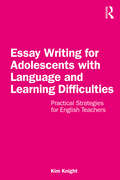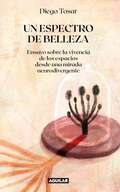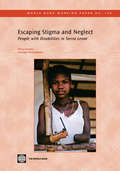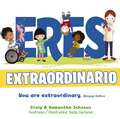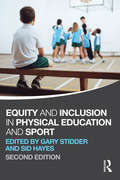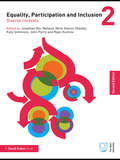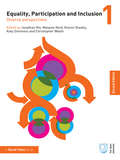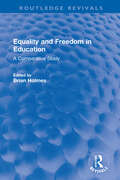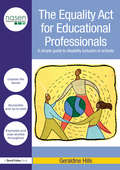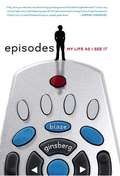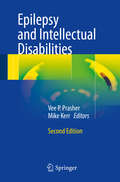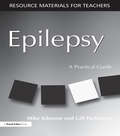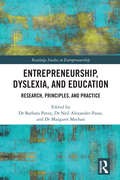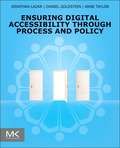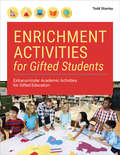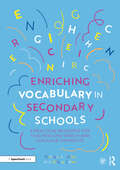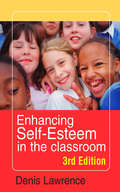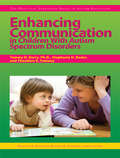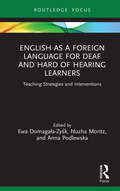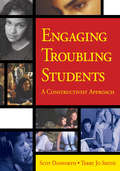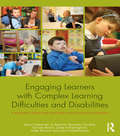- Table View
- List View
Essay Writing for Adolescents with Language and Learning Difficulties: Practical Strategies for English Teachers
by Kim KnightEssay Writing for Adolescents with Language and Learning Difficulties is a step-by-step guide for educators teaching secondary students with language difficulties how to write an English essay and, more importantly, how to do this on their own. Essay writing is one of the most difficult skills that secondary school students need to develop, though there are limited resources available to support these students and their teachers. Based on research into language disorders in adolescence and language processing, the strategies in this book are easy to apply and represent a scaffolded and sequenced approach to teaching essay writing. The book's structure encourages students' skills and confidence to be developed gradually, each chapter building on the last, beginning with the early stages of text analysis and progressing through to writing a complete essay. While written with students with language difficulties in mind, the strategies in this book are applicable to teaching all secondary school students. Written by a speech pathologist with over a decade’s experience working in secondary schools, this book is an essential resource for all high school English teachers and any education professionals responsible for teaching adolescents how to write essays competently and confidently.
Un espectro de belleza: Ensayo sobre la vivencia de los espacios desde una mirada neurodivergente
by Diego TosarDiego Tosar nos invita a ir en busca de aquello que nos une con las personas del espectro autista, más que de aquello que nos diferencia, para proponer otra posible arquitectura, una arquitectura repleta de sensibilidad para todos. Este libro es un intento por ampliar la mirada sobre la concepción de los espacios, los cuales no contemplan aún la diversidad que conforma nuestra sociedad. Diego Tosar lleva adelante un análisis reflexivo sobre las características de los entornos discapacitantes para las personas dentro del espectro autista. Propone así estrategias viables para modificar el sistema, en la búsqueda de garantizar un entorno que resulte más amable y que favorezca la convivencia. Una forma de interpretar el propósito de este ensayo es el de lograr una mejor comprensión sobre cómo percibe, cómo procesa y cómo se ve afectada la conducta de diferentes personas dentro del espectro autista, en relación a los estímulos que se le presentan en los ambientes. Por otra parte, este libro es también el ensayo de un padre, de profesión arquitecto, que desde el desconcierto intenta amorosamente comprender a su hijo. Esta vivencia personal se convierte en el motor que impulsa una reflexión personal y profesional ampliada y comprometida.
Escaping Stigma and Neglect: People with Disabilities in Sierra Leone
by Mirey Ovadiya Giuseppe ZampaglionePeople with disabilities in Sierra Leone are disadvantaged in regards to their access to social services and the economic opportunities available to them. Oftentimes, they are marginalized and their rights are ignored. The government of Sierra Leone is taking measures to improve the social and economic situation of people with disabilities in the country. The objective of this note on people with disabilities in Sierra Leone is to: (i) provide a diagnosis on the scale and nature of the problem, (ii) analyze current public policies in support of people with disabilities, (iii) review public and private programs, and (iv) propose policy options to policy makers and development partners. It is meant for policy makers and practitioners in Sierra Leone as well as all those interested in the subject.
Eres extraordinario - Bilingüe
by Craig Johnson Samantha JohnsonCada niño necesita saber que él o ella es excepcional, amado y tiene un propósito. Padres de un niño con autismo, Craig y Samantha Johnson entienden que los niños que son un poco diferentes a los demás a veces necesitan una mayor seguridad de que Dios tiene un propósito increíble para ellos, no solo a pesar de sus diferencias, sino por ellas.En Eres extraordinario, el pastor Craig y Samantha usan rimas divertidas y dibujos coloridos para celebrar a todos los niños, incluidos los niños que tienen desafíos y dones únicos. Cada página de este libro se enfoca en una habilidad o circunstancia diferente, como el autismo, el síndrome de Down, diferentes etnias, tamaños y tipos de cuerpo únicos, limitaciones físicas, cáncer, adopciones y más. Y una carta a los padres al comienzo del libro animará a los padres y cuidadores y les recordará que no están solos.Los autores son los fundadores de Champion Club, un ministerio internacional de la Iglesia Lakewood en Houston, Texas, para niños, adolescentes y adultos con necesidades especiales. Joel Osteen, el pastor principal de Lakewood, es uno de los muchos partidarios conocidos de los Clubes de Campeones de todo el país.Eres extraordinario ayuda a promover la inclusión en escuelas, iglesias y grupos sociales. Este es un libro que los padres, abuelos, maestros de escuela dominical y mentores les darán a los niños que tienen circunstancias especiales, así como a los que no, como un recordatorio de que todas las personas son extraordinarias y que Dios nos llama a ser amables y atentos.Es un libro perfecto para las Casas Ronald McDonald, los atletas de Olimpiadas Especiales, los eventos de Joni and Friends, los participantes de Best Buddies, los grupos de apoyo a la adopción, las campañas contra el acoso escolar y las asociaciones locales de síndrome de Down o autismo.Con su mensaje educativo, divertido y edificante, Eres extraordinario recuerda a los niños y adultos que el mundo es un lugar hermoso cuando tratamos a todos como las personas excepcionales que son.
Equity and Inclusion in Physical Education and Sport (2nd Edition)
by Gary Stidder Sid HayesAn essential component of good practice in physical education is ensuring inclusivity for all pupils, regardless of need, ability or background. Now in a fully revised and updated new edition, Equity and Inclusion in Physical Education fully explores the theoretical and practical issues faced by physical education teachers today. The book amalgamates areas of critical debate within the world of physical education and is structured around the key topics of ability, special educational needs, gender, sexuality, social class, race and ethnicity. These issues are discussed in relation to principles of equity, equality of opportunity, pedagogy, differentiation, curriculum planning and cultural awareness. Other chapters explore contemporary themes such as healthism and obesity and values in physical education and policy, whilst a chapter new to this edition demonstrates the importance of reflexivity and critical self-reflection in good inclusive practice. As well as being a perfect introductory text for any course on inclusion or inclusive practice in physical education, the book offers invaluable, practical advice for established professionals, newly qualified teachers and trainees about how to meet equity and inclusion requirements. Examples of good practice are included throughout, as well as guidance on how to implement an inclusive PE curriculum within the school.
Equality, Participation and Inclusion 2: Diverse Contexts
by Jonathan Rix Melanie Nind Kieron Sheehy Katy Simmons John Parry Rajni KumraiWhat are the experiences of children and young people? How can we think about the challenges they face? What systems and practices can support them? How can we develop greater equality, participation and inclusion across diverse settings? This second edition of Equality, Participation and Inclusion 2: Diverse Contexts is the second of two Readers aimed at people with an interest in issues of equality, participation and inclusion for children and young people. This second Reader focuses in particular upon the diverse experiences and contexts in which children and young people encounter issues of equality, participation and inclusion. Comprising readings taken from the latest research in journal articles, newly commissioned chapters, as well as several chapters from the first edition that retain particular relevance, this fully updated second edition has broadened its focus to consider a wider range of diverse experiences and contexts, whilst maintaining an emphasis on educational settings. Drawing on the writing of academics, practitioners, children and young people, this collection is a rich source of information and ideas for students and practitioners who are interested in thinking about how inequality and exclusion are experienced, and how they can be challenged, and will be of particular interest to those working in education, health, youth and community work, youth justice and social services. Families and advocates are also likely to be drawn to the material as much of it reflects on lived experiences and life stories.
Equality, Participation and Inclusion 1: Diverse Perspectives
by Jon Rix Melanie Nind Kieron Sheehy Katy Simmons Christopher WalshWhat are the experiences of children and young people? How can we think about the challenges they face? What systems and practices can support them? How can we develop greater equality, participation and inclusion across diverse settings? This second edition of Equality, Participation and Inclusion 1: Diverse Perspectives is the first of two Readers aimed at people with an interest in issues of equality, participation and inclusion for children and young people. This first Reader focuses in particular on the diverse perspectives held by different practitioners and stakeholders. Comprising readings taken from the latest research in journal articles, newly commissioned chapters, as well as several chapters from the first edition that retain particular relevance, this fully updated second edition has broadened its focus to consider a greater diversity of perspectives. Whilst exploring how we think about the experiences of children and young people across a range of contexts it maintains a subtle, underlying emphasis upon education and the experiences of disabled people. Drawing on the writing of academics, practitioners, children and young people, and people who have experienced exclusion, this book is a rich resource for students and practitioners who are interested in thinking about how inequality and exclusion are experienced, and how they can be challenged. Much of the material reflects on lived experiences and life stories, and will be of particular interest to those working in education, health, youth and community work, youth justice and social services, as well as to families and advocates.
Equality and Inclusion for Learning Disability Workers
by Rorie Fulton Kate RichardsonIf you are working within the learning disability sector and studying for the QCF Diploma in Health and Social Care, you will find this book invaluable in helping you to achieve the unit on Equality and Inclusion. It shows the importance of understanding issues of equality and inclusion in your role and of working in an inclusive way. The book is easy to navigate, with each chapter covering one of the learning outcomes within the unit. Each chapter begins with an example taken from real people's stories and lots of activities, photographs and other illustrations are included throughout.
Equality and Freedom in Education: A Comparative Study (Routledge Revivals)
by Brian HolmesFirst published in 1985, Equality and Freedom in Education investigates the extent to which it is possible or desirable to provide equal opportunities in education, regardless of age sex, race, language, and social class. Attempts to make such provision regularly attract the criticism that they remove the freedom of parents and religious bodies to educate children in accordance with their particular wishes. To understand this dilemma, the book analyses the educational systems and practices in England and Wales, France, the USA, the USSR, China and Japan. Information about each system is provided in accordance with a taxonomy, developed by Professor Holmes for the International Bureau of Education in Geneva, and widely accepted by Ministries of Education throughout the world. Simplified diagrams show how school systems are organised and how children pass through the school system, and essential statistical information, taken from UNESCO sources, is also provided. The book will be of interest to students of education and sociology.
The Equality Act for Educational Professionals: A simple guide to disability inclusion in schools (nasen spotlight)
by Geraldine Hills"A definite must for SENCOS." -- Urmston Junior School "A good insight into process of tribunal and what the Equality Act means." -- Team Leader, St Paul's CE Primary School 'A much needed resource in supporting schools, centres, day nurseries and community childcare provision to understand the complexity of the issues surrounding SEN... A valuable tool.’ -- Gerri Ross – Head of Old Moat Sure Start Children’s Centre, UK "Straightforward and easily accessible...I would recommend this book to undergraduates and professionals alike who have an interest in ensuring that the rights of disabled children are upheld." -- Dr Craig Blyth, School of Education, University of Manchester, UK Under the Equality Act (2010), all schools and service providers have a legal obligation to make provision for disabled pupils, staff and school users. If you’re feeling confused and concerned about the content and implications of the Disability Duty Act (1995) and the more recently released Equality Act (2010), and how it affects your setting, this essential book will help you unpick the issues in a user-friendly and easily accessible way. This highly practical resource: explains the main parts of Equality Act (2010) as it affects disability in a way that will encourage all members of staff within a school to feel confident that they are correctly implementing its requirements; discusses ‘reasonable adjustments’ and ‘less favourable treatment’ which are at the heart of the legislation; shows how ‘less favourable treatment’ and ‘reasonable adjustments’ apply to admissions, exclusions, handling of medicines and during school trips; uses examples and case studies throughout, and highlights the key factors for success in making reasonable adjustments; takes readers through the process of an alleged act of discrimination against the school, and how it may be resolved, up to and including the SEND tribunal process. The author brings a wealth of experience to this topic, both as a parent of a disabled child and as a trainer of professionals. She uses her unique insight to develop skills and awareness in anyone who follows her material, and shows through tried and tested concepts and methods, how schools and settings can avoid costly and stressful tribunals. Headteachers, teachers, SENCos, Sure Start Centre Managers and anyone who works in educational settings will find this book essential to their professional development and a fantastic source of support and help.
eQuality
by Peter Blanck J. D. David BraddockNever before have the civil rights of people with disabilities aligned so well with developments in information and communication technology. The center of the technology revolution is the Internet's World Wide Web, which fosters unprecedented opportunities for engagement in democratic society. The Americans with Disabilities Act likewise is helping to ensure equal participation in society by people with disabilities. Globally, the Convention on the Rights of Persons with Disabilities further affirms that persons with disabilities are entitled to the full and equal enjoyment of fundamental personal freedoms. This book is about the lived struggle for disability rights, with a focus on Web equality for people with cognitive disabilities, such as intellectual disabilities, autism, and print-related disabilities. The principles derived from the right to the Web - freedom of speech and individual dignity - are bound to lead toward full and meaningful involvement in society for persons with cognitive and other disabilities.
Episodes: My Life as I See It
by Blaze GinsbergFrom the author's mother: When Blaze was about ten years old, he gave me a perfect description of how his mind worked. Actually, it was more of a description of the way everyone's mind worked--at least from his perspective.
Epilepsy and Intellectual Disabilities
by Vee P. Prasher Mike KerrThis second edition of a successful book provides updated clinical and research knowledge, including information on the licensing of new antiepileptic drugs. All chapters are updated to reflect present accepted practice. New chapters highlighting the importance of the genetic aspects of epilepsy, nonpharmacological treatments, and the impact of epilepsy on families and carers have been added. Ongoing developments in the general population, which will more likely than not become relevant to the intellectually disabled population, are discussed. The impact of epilepsy on the person themselves and their carers is acknowledged, and person-centred treatment programs with a multifaceted team approach are proposed. This book is aimed at physicians and residents in neurology and pediatrics, as well as other practitioners working with this population, such as neuropsychologists. Epilepsy and Intellectual Disabilities, Second Edition is recommended reading for all those caring for this important group of individuals.
Epilepsy: A Practical Guide (Sen Ser.)
by Mike Johnson Gill ParkinsonThis book looks at epilepsy in children. How is it classified, managed and treated? What is the impact on the family and the child involved? How does this affect progress in school and access to the curriculum? There are sections on assessment and diagnosis of epilepsy; epilepsy and behavior; epilepsy and genetics; the implications for schools, the classroom and learning; how access to the curriculum might be increased; social aspects of epilepsy; and language and communication problems associated with epilepsy. Apart from sound content and clear, practical guidance, the reader will also find a glossary of terms, a seizure description chart, a risk assessment chart, a list of useful addresses and an annotated bibliography. This book will be useful to all teachers, SENCOs, Teaching Assistants, Speech and Language Therapists, Educational Psychologists, GPs, parents and carers of children with epilepsy.
Entrepreneurship, Dyslexia, and Education: Research, Principles, and Practice (Routledge Studies in Entrepreneurship)
by Barbara PaveyThe development of entrepreneurial abilities in people with dyslexia is a subject of great interest. It has gained increasing importance in economically difficult times because of its potential for the development of new business opportunities. This book brings together contributions from researchers, educators, and entrepreneurs with dyslexia, investigating this subject from many perspectives. Is there something different in the profile of a person with dyslexia that supports the development of entrepreneurship? This book aims to draw out key themes which can be used in education to motivate, mentor, and create the business leaders of tomorrow. It offers a fundamental text for this area of study with a comprehensive, international examination of its topic. It includes views by new and established international writers and researchers, providing up-to-date perspectives on entrepreneurship, dyslexia, and education. It is accessible to read, to understand, and to learn from, and is suitable for recommended reading for graduate and postgraduate students. The diverse views and perspectives demonstrated in this book make it as relevant as possible for a wide group of readers. It informs study in the fields of business and dyslexia, and will be of interest to educators, researchers, and to anyone interested in the overlap of entrepreneurship and dyslexia.
Ensuring Digital Accessibility through Process and Policy
by Jonathan Lazar Daniel Goldstein Anne TaylorThis book provides readers with a resource to digital accessibility from both a technical and policy perspective.
Enrichment Activities for Gifted Students: Extracurricular Academic Activities for Gifted Education
by Todd StanleyEnrichment Activities for Gifted Students outlines a variety of extracurricular academic activities and programming options for gifted student talent development. This book:Includes strategies for educators to develop enrichment programs that fit the needs of their students.Provides numerous examples of nationally-recognized and easy-to-implement programs and competitions.Helps promote students' academic growth.Categorizes options by subject area, including math, science, language arts, and social studies.Categorizes options by skill type, including creative thinking and leadership.Enrichment Activities for Gifted Students provides everything busy educators need to know about offering, funding, and supporting enrichment activities and programs that develop students' content knowledge and expertise, build valuable real-world skills, and extend learning beyond the walls of the classroom.
Enriching Vocabulary in Secondary Schools: A Practical Resource for Teachers and Speech and Language Therapists
by Victoria Joffe Hilary LoweEnriching Vocabulary in Secondary Schools explores the importance of vocabulary for academic, social, emotional, and employment outcomes. It describes the vulnerability of vocabulary skills in children and adolescents with speech, language, and communication needs (SLCN), and suggests practical ways to support them as they learn. The book contains a theoretical overview of vocabulary development in children and adolescents, highlighting its impact on both learning and psychosocial functioning, and profiles the vocabulary learning of children with SLCN. It includes a range of programmes, strategies, and resources for vocabulary learning, together with the evidence base and key research underpinning them. Chapters offer a plethora of word-learning activities, ideas, and downloadable resources for implementation in the classroom, small groups, and individually to meet the needs of pupils with differing levels of language and cognitive ability. An essential resource for speech and language therapists, secondary school teachers, and support staff, this book will give readers a deeper understanding of the significance of language, along with an extensive practical toolkit to help teach and enhance the vocabulary learning of older children and young people.
Enhancing Self-esteem in the Classroom (One-off Ser.)
by Dr Denis LawrencePraise for the first edition: `The underlying philosophy of this practical book is that raising self-esteem in pupils (including dyslexics) will lead to achievement of higher academic results and fewer behaviour problems. This book is primarily for primary and secondary teachers but would provide much material for discussion among SpLD teachers, given the unexpected and controversial results of Denis Lawrence's research' - Dyslexia Contact `Many useful suggestions offered in this book about learning activities are likely to help pupils to feel better about themselves, to learn to respect others and to experience how feelings can be expressed safely' - British Journal of Special Education Raising self-esteem in pupils can lead to the achievement of higher academic results and fewer behavioural problems. Outlining in simple terms what self-esteem is and providing strategies to support it in the classroom, this book includes clear explanations of the terminology and theory behind self-esteem, and lots of practical examples and useful activities for use with children. The book also covers the main issues surrounding the self-esteem of practitioners. It sets out tried-and-tested strategies that teachers can use to recognise and reduce stress and maintain their self-esteem. This new edition has been fully updated and now includes new case study material and activities.
Enhancing Communication in Children With Autism Spectrum Disorders
by Tammy D. Barry Stephanie H. Bader Theodore S. TomenyEnhancing Communication in Children With Autism Spectrum Disorders presents an overview of impairments in communication among children with an ASD. A variety of techniques for implementing interventions are highlighted including applied behavior analysis, token economy systems, social skills groups, and more.
English to Use
by Barbara A. Trautman David H. TrautmanEach chapter of this book will help you to communicate better in English. Illustrations in each chapter will show how hearing-impaired people communicate words or a sentence that you are learning in English. Clear communication can connect people with one another both in words and in signs.
English / Spanish Basics for Orientation and Mobility Instructors
by Christian J. FoyThis book was written as a teaching aid for orientation and mobility (O&M) instructors. Author's intention is not to teach the techniques of the profession but to supply the vocabulary instructors might use to teach students in Spanish.
English as a Foreign Language for Deaf and Hard of Hearing Learners: Teaching Strategies and Interventions (Routledge Research in Special Educational Needs)
by Ewa Domagała-Zyśk; Nuzha Moritz; Anna PodlewskaThis book outlines best practice and effective strategies for teaching English as a foreign language to D/deaf and hard of hearing (DHH) students. Written by a group of researchers and experienced practitioners, the book presents a combination of theory, hands-on experience, and insight from DHH students. The book brings together a variety of tried and tested teaching ideas primarily designed to be used for classroom work as a basis for standby lessons or to supplement courses. Placing considerable emphasis on practical strategies, it provides educators and practitioners with stimulating ideas that facilitate the emergence of fluency and communication skills. The chapters cover a wide range of interventions and strategies including early education teaching strategies, using sign -bilingualism in the classroom, enhancing oral communication, speech visualization, improving pronunciation, using films and cartoons, lip reading techniques, written support, and harnessing writing as a memory strategy. Full of practical guidance grounded in theory, the book will be a useful resource for English teachers and all those involved in the education of deaf and hard of hearing learners across the world; including researchers, student teachers, newly qualified teachers, school supervisors, and counsellors.
Engaging Troubling Students: A Constructivist Approach
by Scot Danforth Terry Jo SmithFilled with rich narrative and designed for educators working with troubling students each day, this insightful, practical guide leads you in developing helpful, trusting student-teacher relationships.
Engaging Learners with Complex Learning Difficulties and Disabilities: A resource book for teachers and teaching assistants
by Barry Carpenter Jo Egerton Beverley Cockbill Tamara Bloom Jodie Fotheringham Hollie Rawson Jane ThistlethwaiteChildren and young people with Complex Learning Difficulties and Disabilities (CLDD) have co-existing and overlapping conditions which can manifest in complex learning patterns, extreme behaviours and a range of socio-medical needs which are new and unfamiliar to many educators. Their combination of issues and layered needs – mental health, relationship, behavioural, physical, medical, sensory, communication and cognitive – mean they often disengage from learning and challenge even our most experienced teachers. This book provides school practitioners and leaders with an approach and resources to engage this often disenfranchized group of children in learning. The Engagement for Learning Framework has been developed and trialled by over 100 educational settings (both special and mainstream) with learners from early years to post-16. It gives practitioners from a range of disciplines a shared means of assessing, recording and developing personalized learning pathways and demonstrating progression for these children. The focus on inquiry means that however complex a young person’s needs, educators will be able to apply the approach. This practical and engaging book provides literature, tools and case study examples outlining who children and young people with CLDD are, why their engagement for learning is important and how the Engagement for Learning Framework can be used effectively by teachers and other professionals to ensure the best possible outcomes for these children.
